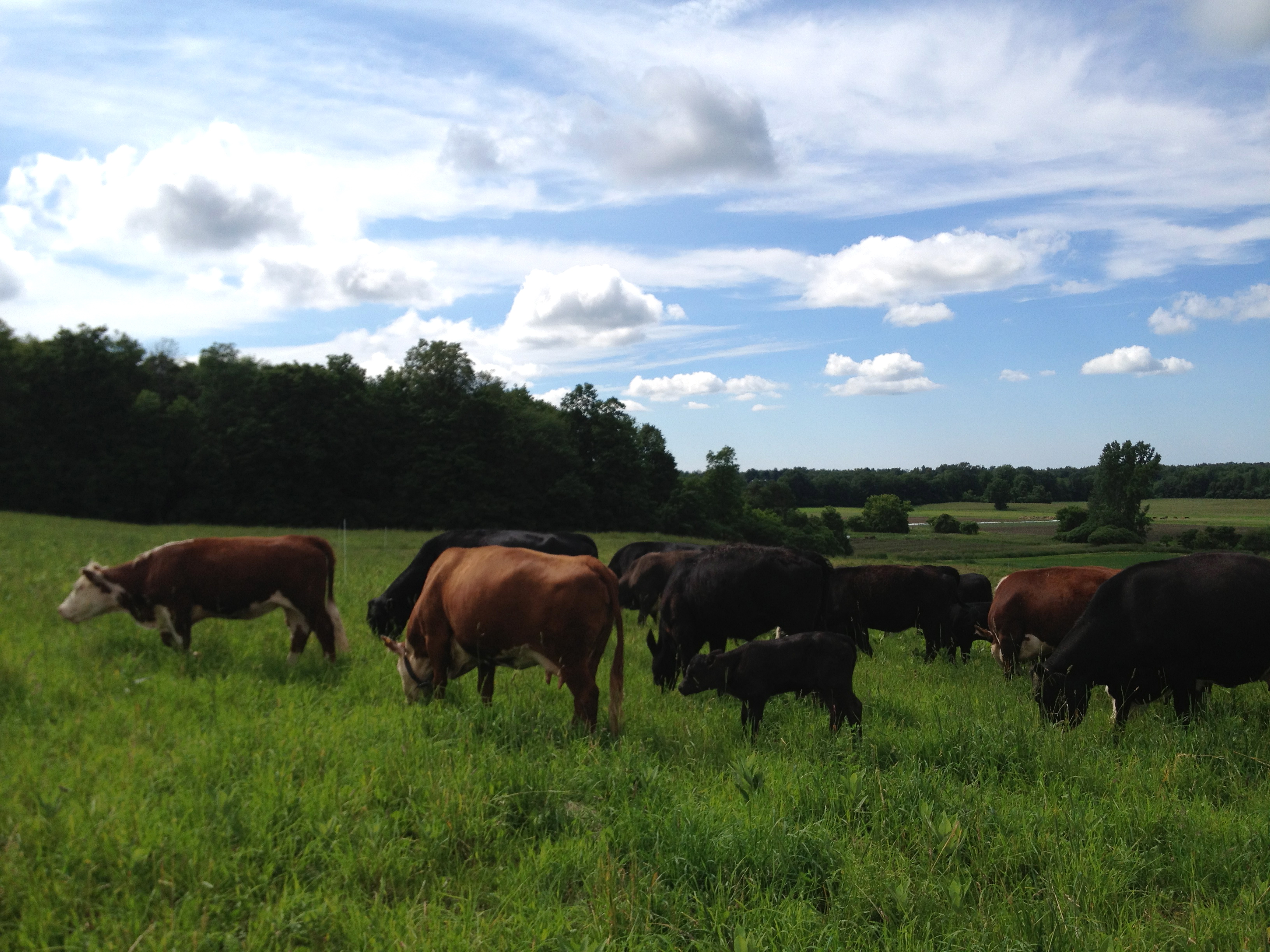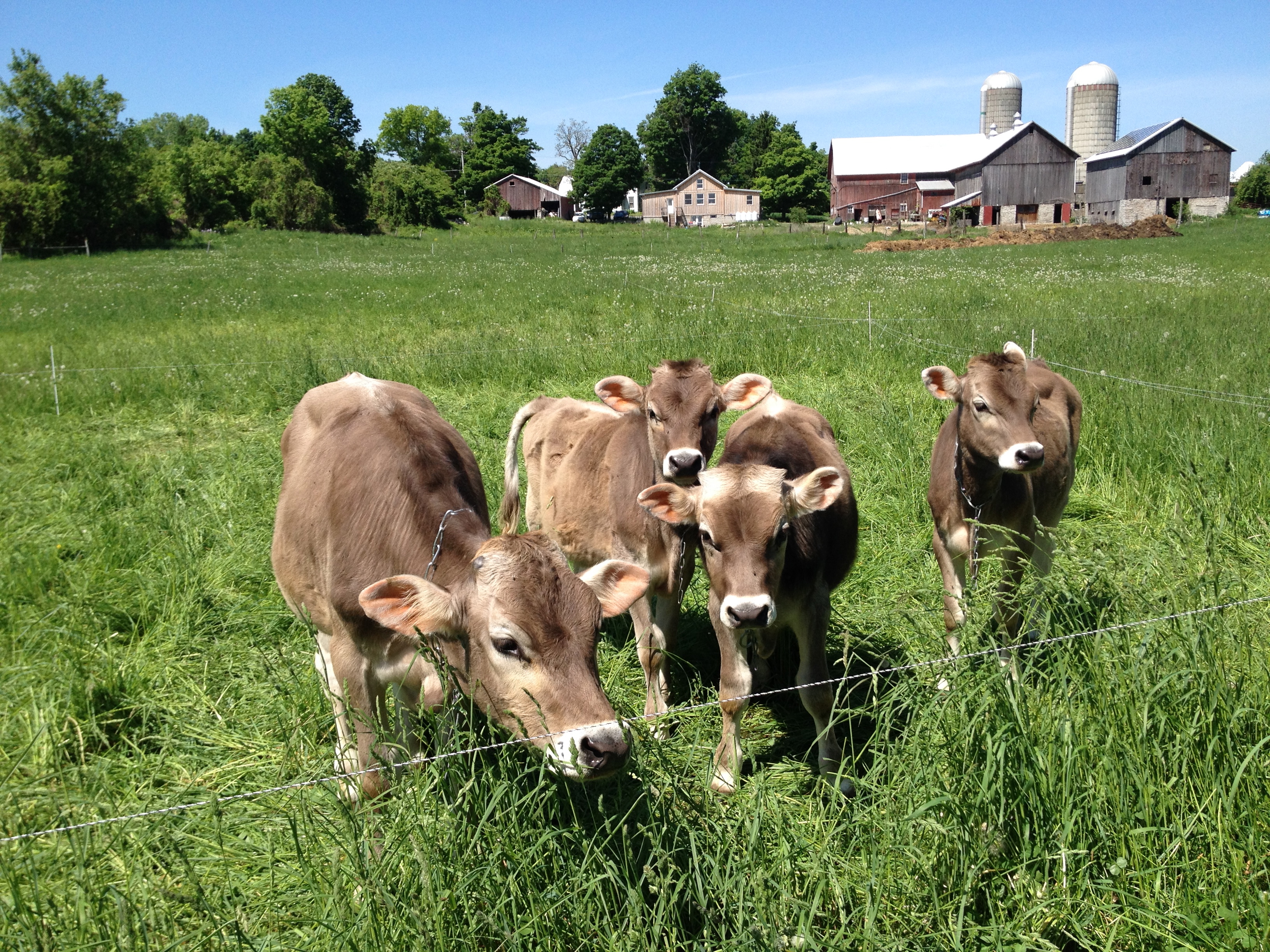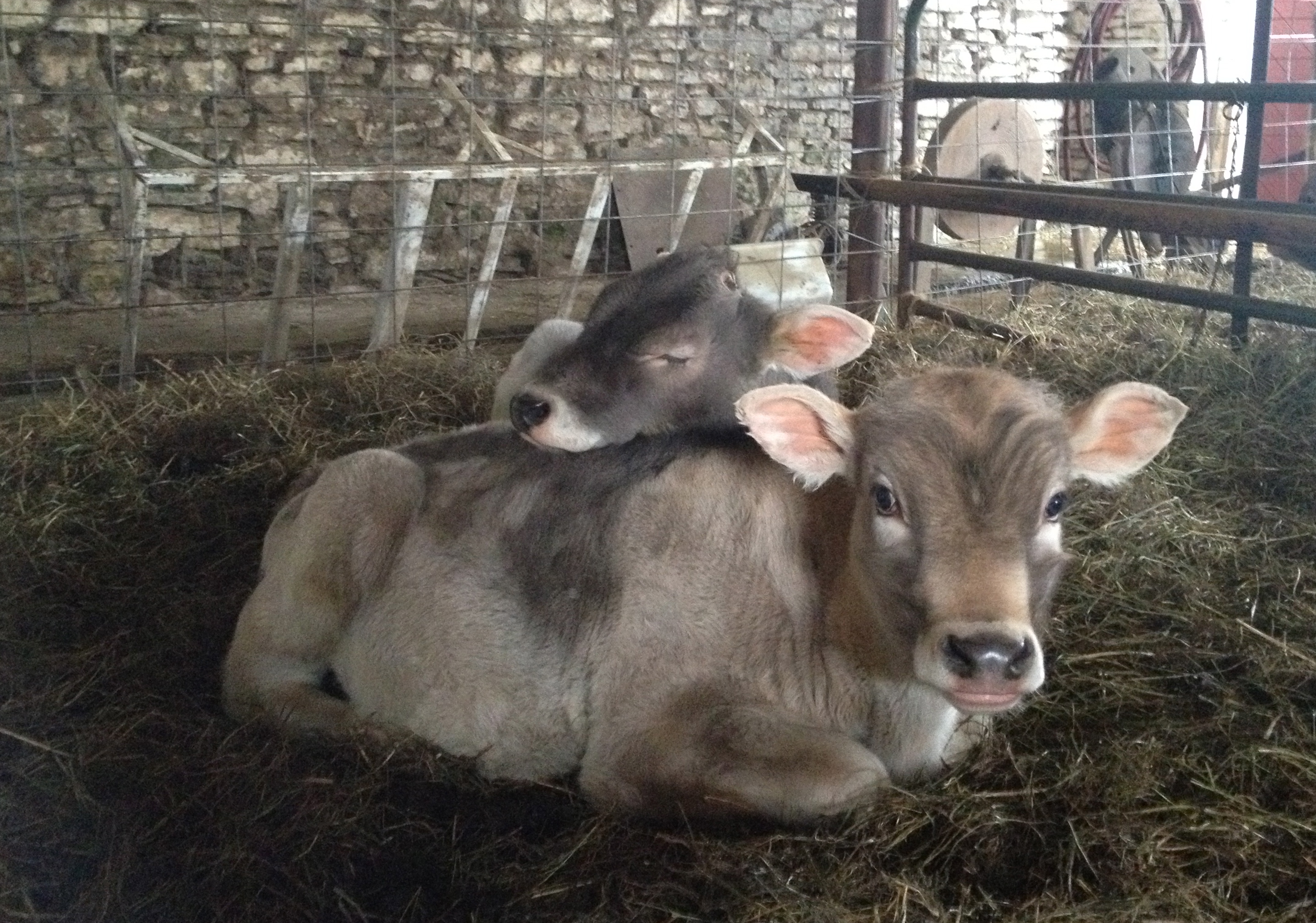a literary journal published by the Black Earth Institute dedicated to re-forging the links between art and spirit, earth and society
Stephanie Nelson
Whose Muscle is on My Plate?
For all the meat I’ve eaten in my life, I’ve only watched a large animal die on three occasions. The first time I witnessed this crucial moment was while working as a livestock intern during the summer of 2013. I had never worked with meat animals before and was curious to experience the relationship people develop with animals bound for the table.
As a kid I showed dairy calves at the county fair. My sisters and I would bike over to the university dairy farm to work with the calves we had chosen through a 4-H program for town kids. We only showed heifers (young female cows who have not yet had a calf) because the dairy farm staff didn’t want to milk cows at the fair, which would have meant transporting milking machines and dealing with the milk. This rule allowed us to show the same heifer for two years before her first calving. In subsequent years, I would find my former 4-H cows to visit them. They would amble over to the fence to greet me, and I would obligingly give them a good neck scratch; I liked to think they were as happy to see me as I was to see them. So my bovine experience was decidedly pet-like as I approached my new livestock job.
I also had limited meat-cooking experience when I began working that summer. I was a vegetarian briefly in college, primarily because I only wanted to buy meat from animals raised in a manner that I wanted to support, and I didn’t feel I could afford the correspondingly higher price. When I did add meat back into my diet, I preferred for it to arrive on my plate cooked by someone else, thus avoiding that slimy tactile sensation of “this is an animal’s muscle.” That avoidance, however, felt immature. I decided if I was going to eat it, I wanted to understand the whole process.
My supervisor for that summer livestock internship was Sam, the livestock manager and butcher at the farm. Part of my job was helping Sam in the farm’s on-site butcher shop, wrapping steaks and bacons carved from the cows and pigs I had also been caring for in life. One of my first tasks was pushing the odd-shaped bits (leftover after the steaks and roasts were cut) through the meat grinder and then weighing and forming one-pound balls of the cold, sticky ground beef or pork. I quickly got over any squeamishness; meat grinders are matter-of-fact machines that do not lend themselves to delicacy. The sound of Sam pushing soon-to-be pork chops through the electric bone saw furthered the utilitarian mood.
This on-farm processing was a big draw for me because it eliminated from the animals’ lives the highly stressful act of transporting them to a slaughterhouse. But I had still only seen part of this process. The first step enabling the transformation of animal to meat was a well-planned and precisely performed death. I told Sam I wanted to watch him slaughter a cow.
The closest view of meat-as-cow I had seen so far was Sam sawing a skinned, headless cow carcass apart, right down the spine, in order to begin breaking it down into recognizable cuts I would help wrap later. Sam was wearing his blood-splattered bright orange rain bibs, which we cheekily called “foul-weather gear.” He was standing on a stepladder to reach the tailhead of the cow carcass. Sam seemed almost wedged inside the body cavity of the carcass, wielding a Sawzall, which is the robust construction-worker cousin of an electric carving knife. Lacy streaks of fat partially covered the red muscles of the hind legs that stretched upward above him.
The 500- or 600-pound carcass was suspended: heavy-duty chains wrapped around a rafter and attached to a metal brace. A 2-inch hook on each end of the brace pierced the space between the hock and the tendon on each back leg. As soon as Sam finished cutting, the two halves of the carcass gently swung apart, balancing on either end of the metal brace. I held the doors open as Sam and another farmer heaved the deadweight halves of beef over their shoulders to share the load, carrying each half into the walk-in cooler one at a time.
One cloudy, misty morning a couple of weeks later, I found myself balancing on the 2-inch wide towing coupler at the back of the tractor. I was clutching Sam’s .22 rifle in one hand and the back of his seat with the other to stabilize myself for the bumpy ride to Beef Hill, the pasture where the heifer (whose time, Sam had decided, had come) was eating contentedly with her herd-mates.

Up to that point, my interactions with these cows had been to build their paddocks within the larger pasture. Every couple of days, I paced out each new paddock based on the height and density of the plants in that stretch of pasture. I set up corner braces with fiberglass posts, which I hammered into the ground. I unreeled the polywire, a braided rope of wire and plastic, between each brace, making figure-eight knots at every corner and end to hold the length taut. Every day at six in the morning and four in the afternoon, I removed the red clip connecting the fence to the charger that was “heating” it, then unhooked and wound a few yards of polywire around my arm to allow the herd into their fresh paddock. I called them through the opening with a low “come on, come on” repeated continuously until all had passed. As they walked by, I noted the health of each cow, calf, and heifer.
On this slaughter day, Sam drove the tractor as close as he could below the paddock where the herd was grazing. The heifer he planned to shoot had been purchased, along with a second heifer, from another farm to help augment our beef supply for the farm’s regular customers. Being from a different farm meant those two heifers stuck close together, not yet fully integrated with the rest of the herd. All the cows were at the far end of their paddock, though some had stopped grazing to watch our approach, ever curious about activity beyond their daily routine. I hung back as Sam stood a few feet outside of the polyline and called them closer with the familiar “come on, come on” call that usually promised fresh grass. The brown and white heifer he wanted came close, looking straight at him, curious and alert.
Sam brought the rifle up to his shoulder; in his left hand he also held a sharp, slightly curved knife parallel with the barrel. He sighted and then pulled the trigger. The heifer’s large body dropped instantly, seemingly at the same time as I heard the crack of the gunshot. She had been hit between and just above the eyes. “Textbook,” I heard Sam mutter quietly, pleased with the shot, but not pausing longer than a split second. He quickly handed me the gun and then rushed to the dead cow to slit her throat just below the jawbones. Bright red blood pumped onto the grass out of her now open neck. Sam stepped back as soon as he made the cut; the heifer’s legs were kicking wildly. She was dead, had died instantly, but her legs appeared to be running from a foe she would never escape, the nerves and muscles in her body somehow still enacting the flight reaction. I must have looked concerned, for Sam reassured me that such violent twitching was normal.
The other cows had also been watching. Some had already gone back to grazing, while a few came up to the dead heifer to sniff her and the pool of blood seeping into the soil as her body slowly quieted and became still. As I watched this larger scene, Sam was already back to work, lowering the polywire line and attaching a chain to the heifer’s back leg so he could pull her up with the tractor and drive her, suspended, back to the barnyard. Once there he would remove her skin, guts, organs, legs, and head, and then saw her in half and hang her in the butcher shop walk-in cooler for a few days before cutting her into recognizable steaks, roasts, and ground beef. At what point, I wondered, does a meat animal become just meat – “it” instead of “she?”
Sam climbed onto the tractor seat and slowly operated the levers to lift the bucket to which the heifer was chained, lifting her awkwardly over the paddock fence. Her body swayed from the chain as he turned the tractor around. He paused to catch my eye, asking in his upbeat way if I was all right and would I please stay back to readjust the polywire. I nodded, making an effort to give a bright, I’m-game-for-this smile. In truth, I had been blinking back tears, and I hoped he hadn’t noticed. I watched as he drove slowly down the lane, the dead heifer dangling clumsily in front.
I became aware that, though the rest of the herd was back to grazing, the second heifer that had been purchased was watching the procession too. Though I watched in silence, she bellowed after her cohort – in sadness? In confusion? That was all it took for my own emotion to swell up fully, and I cried. The force of my feelings surprised me. I sat in the grass for a moment. No matter how well the animal is cared for in life or how carefully the death is delivered, it is still a loss.
As I walked back along the lane after finishing with the fences, I found myself following the trail of blood that had dripped every 10 feet or so from the suspended heifer: wet, bright red splatters vivid against the green grass. I reminded myself that her life in that form, in those beef cow-clothes, would not exist without this purpose. When raising meat animals, a definite shift in our relationship occurs; they are still carefully tended and, yes, sometimes named, but affection is usually limited, just to spare our own emotions. I began to question this tendency.
About five months later I was back at the farm, this time working with the small dairy herd. Walking into the barn on a cold winter’s day, the three 3-month-old dairy calves were waiting for their bottles. Two of the calves, Piggy and Mischief, were heifers. Their intended lifespan was hopefully at least 12 years; once they reached the breeding age of 2 years, they would be bred, calve, and be milked year after year. The third calf was a bull named Nuke. The farm owner considered whether he would raise Nuke to breed but decided instead he would be slaughtered for veal, at the age of about 6 months.
I did not enjoy the chore of bottle-feeding the calves, but it is a typical dairy farm practice enabling the farmer to decide exactly how much to feed each calf, so that enough milk is available to sell in an effort to ensure economic stability. As I held the bottles for the calves, I braced myself against their enthusiastic bunting. Whenever I walked by their group pen, they excitedly came up to the fence and stretched out their necks, checking for a bottle or perhaps asking for a neck rub. I noticed that I was already distancing myself from Nuke, not giving him as much attention. It’s true that part of the reason for socializing dairy heifers is that they will be worked with much more intimately for many years. But I realized that my distance from Nuke was just an attempt to spare my own emotions. Didn’t he deserve as much affection – or perhaps even more – in his shorter life?

With the arrival of spring came the fast-growing grass in the pastures. I set up paddocks for the calves and the milking herd, just as I had done for the beef herd previously. It was wonderful to see the little ones race around the pasture and learn to graze after a winter of eating hay in their small barn pen. The months slipped by.
I happened to be gone the weekend Sam slaughtered Nuke. For what it’s worth, I had said goodbye before I left. When I returned, it was strange to see just Mischief and Piggy in their paddock, looking up at me bright-eyed. Nuke was the first animal I ate knowing whom I was eating. The freezers always held enough beef to hide an individual cow’s identity, but the packages marked “veal” were unmistakably Nuke. I pan-fried the veal cutlet with shallots and savored every bite.
The process towards seeking and building relationships with the animals I eat happened slowly. I didn’t realize how embedded I was in this new perspective until I joined some friends for Thanksgiving. I was telling them about my recent farm work. My friend’s dad was excited to tell me about a farm near his house where he had enjoyed buying meat and cheese, raving about their wonderful products; however, one afternoon, instead of just picking up his food, he went on their farm tour. He saw the pigs frolicking in the pasture and was so struck by their cuteness that he refused to buy pork from that farm again. I asked if he continues to eat any pork. “Why yes,” he exclaimed, but he wanted it to be unidentified. He couldn’t bear the thought that he was eating those happy-looking pigs that he had seen alive.
I have made the opposite decision. After being involved in the lives and deaths of these animals, I don’t want to go to a too-bright store to buy the seemingly sterile, plastic-wrapped chunks of anonymous flesh resting on a Styrofoam tray, so removed from the life from which it was cut. I would rather acknowledge the sadness of the loss, living consciously with the contradiction that death is nourishing me.

Stephanie Nelson worked on farms for the past two years, with experiences ranging from plowing with Percherons three-abreast in Eastern Texas to driving truck for a 3,000-acre wheat and barley harvest in Northern Montana. She’s found writing and photography to be instrumental tools for investigating her connection to and dependency on the lives and deaths for which she’s had direct responsibility. She can be found at https://postagestampprairie.wordpress.com/.
©2025 Black Earth Institute. All rights reserved. | ISSN# 2327-784X | Site Admin